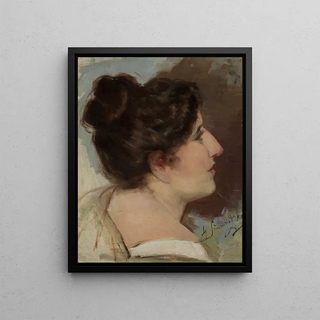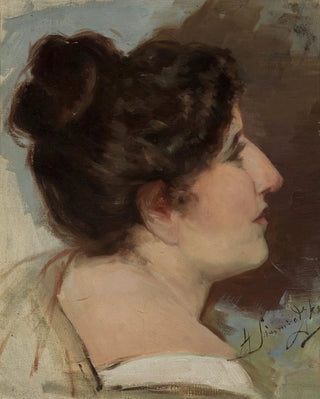Art print | Study of a head - Henryk Siemiradzki


View from behind

Frame (optional)
The artwork "Study of a Head" by Henryk Siemiradzki is a poignant testament to the artistic mastery of the Polish painter, whose talent has transcended ages. This study, distinguished by its psychological depth and meticulous attention to detail, immerses us in the fascinating universe of the late 19th century, a time when art was closely intertwined with the intellectual and aesthetic currents of its era. Contemplating this piece, one is immediately struck by the intensity of the gaze, which seems to capture a fleeting emotion, an ephemeral thought. Through this study, Siemiradzki invites us to explore the subtleties of the human soul, through the simple representation of a head—a stylistic exercise that reveals his virtuosity.
Style and uniqueness of the work
The aesthetic of "Study of a Head" is characterized by fine lines and a delicate use of colors that highlight the depth of the depicted face. Every shadow, every light is carefully crafted, demonstrating impeccable technique reminiscent of the great masters of classical painting. What makes this work unique is its ability to transcend a mere academic exercise to become a true exploration of human psychology. The way Siemiradzki captures nuances of expression, the subtleties of the gaze, creates an immediate connection with the viewer. One almost feels a silent conversation, an intimacy established between the artwork and its observer. It is this magic, this evocative power, that makes this study much more than a simple sketch, but an open door to the soul.
The artist and his influence
Henryk Siemiradzki, an emblematic figure of academic painting, established himself on the European artistic scene through his innovative approach and his ability to combine tradition and modernity. Trained at the Saint Petersburg Academy of Fine Arts, he was influenced by the major artistic currents of his time, notably realism and impressionism. His work, rich and varied, draws on classical references while incorporating contemporary sensibilities. Siemiradzki was able

Matte finish

View from behind

Frame (optional)
The artwork "Study of a Head" by Henryk Siemiradzki is a poignant testament to the artistic mastery of the Polish painter, whose talent has transcended ages. This study, distinguished by its psychological depth and meticulous attention to detail, immerses us in the fascinating universe of the late 19th century, a time when art was closely intertwined with the intellectual and aesthetic currents of its era. Contemplating this piece, one is immediately struck by the intensity of the gaze, which seems to capture a fleeting emotion, an ephemeral thought. Through this study, Siemiradzki invites us to explore the subtleties of the human soul, through the simple representation of a head—a stylistic exercise that reveals his virtuosity.
Style and uniqueness of the work
The aesthetic of "Study of a Head" is characterized by fine lines and a delicate use of colors that highlight the depth of the depicted face. Every shadow, every light is carefully crafted, demonstrating impeccable technique reminiscent of the great masters of classical painting. What makes this work unique is its ability to transcend a mere academic exercise to become a true exploration of human psychology. The way Siemiradzki captures nuances of expression, the subtleties of the gaze, creates an immediate connection with the viewer. One almost feels a silent conversation, an intimacy established between the artwork and its observer. It is this magic, this evocative power, that makes this study much more than a simple sketch, but an open door to the soul.
The artist and his influence
Henryk Siemiradzki, an emblematic figure of academic painting, established himself on the European artistic scene through his innovative approach and his ability to combine tradition and modernity. Trained at the Saint Petersburg Academy of Fine Arts, he was influenced by the major artistic currents of his time, notably realism and impressionism. His work, rich and varied, draws on classical references while incorporating contemporary sensibilities. Siemiradzki was able






